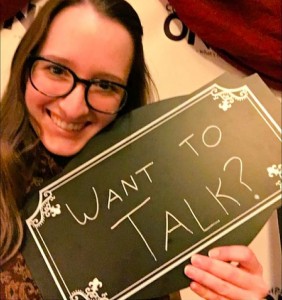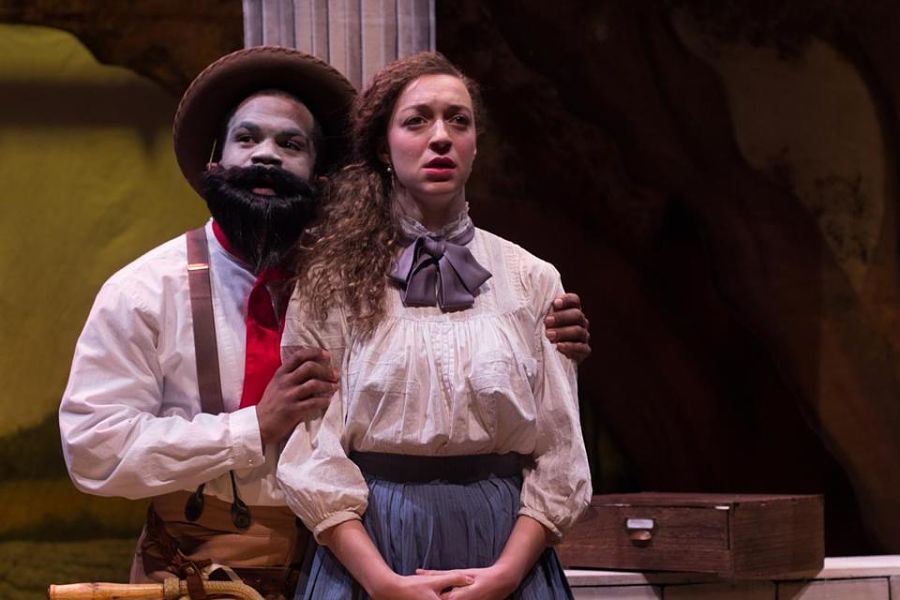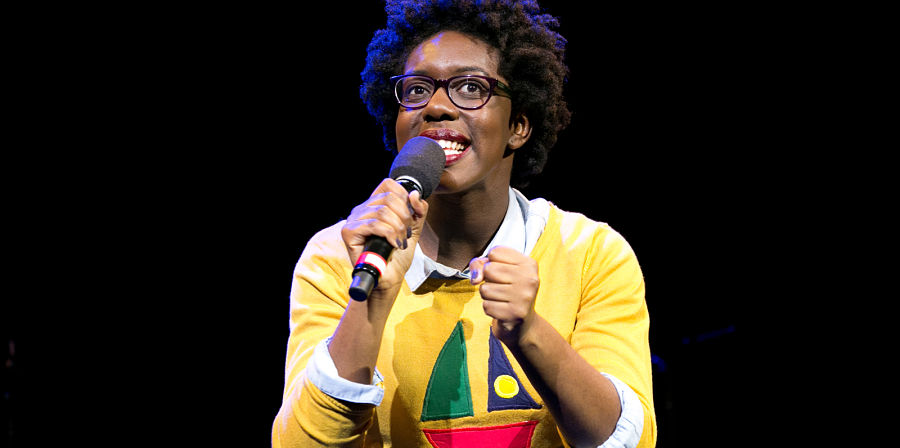BOSTON: When the actors cleared the black box for intermission, the audience shifted uncomfortably. The first act of Company One Theatre’s production of An Octoroon had been long. But after almost two hours of Branden Jacobs-Jenkins’s adaptation of a 19th-century melodrama—complete with plantation setting, race paint, a frightening rabbit mask, and a text infused liberally with the N-word—the audience’s discomfort was not just physical.
“I usually love their work, but this is too weird for me!” one woman apologetically chuckled to an acquaintance in her row, before collecting her belongings and leaving.

Those getting up—and possibly not coming back—had plenty of ways to tell the company how they felt. There were surveys on mini-clipboards under every seat. There was a response board out in the Paramount Theater lobby, filled with Sharpie-scribbled Post-its left by audience members who attended previous performances. And, especially for those not willing to stay for the second half, there were friendly company members waiting in the lobby, holding vintage prop signs that read, “Want to Talk?”
The American theatre community is in the midst of some much needed self-examination. More companies are being held accountable for the diversity of their artists and productions, and more theatre critics are being called out when they put traditionally marginalized people in a figurative box. But are our audiences keeping up? Can or should theatregoers be held accountable for what they choose to engage with? How can companies push the envelope if they’re worried about selling tickets?
Company One has an answer: Don’t stage “issue plays.” Tell really good stories and make sure you invite everyone to join in the discussion.
Haley Fluke, one of the C1 dramaturgs who worked on An Octoroon, stressed the importance of having staff physically present at the theatre and ready to chat.
“One of the things we really value at C1 is breaking down [theatre’s] inaccessibility,” Fluke said. “Once you can talk to someone one on one, and they feel listened to, whatever the strong responses they have, you can work your way toward a middle ground and meet them where they are at.”
One size does not fit all when it comes to C1’s dramaturgical inventory. Before the season even begins, the artistic teams strategize how to create discussion environments uniquely suited for each show. Whether it’s using informal talkbacks, photo booths, video recordings, or formal panels, the company uses a variety of tools to engage different audiences in different headspaces.
A play might make some viewers feel uncertain, uncomfortable, euphoric, energized—or all of the above. But Ilana M. Brownstein, the company’s director of new work, stresses that no outcome is worse than an audience member feeling forced to leave with thoughts unexpressed.
“If we don’t provide that variety of spaces to interact, we lose people,” Brownstein told me. “They may have the impulse to interact with us or with the questions in the play, but if there isn’t something that feels comfortable right away, they may just bolt.”
The opportunity to interact often begins with the programs. C1 staged Ruby Rae Spiegel’s Dry Land in October. The play is about two competitive swimmers on a Florida high school swim team, the unwanted pregnancy one is seeking to end, and the ways the two young women connect over this shared experience.
It would be all too easy to reduce Spiegel’s play to being a story “about” abortion. To avoid this reduction, dramaturg Jessie Baxter posted clips about competitive swimming and teen life on the show’s blog, and printed in the program an interview with the playwright in which Spiegel describes Dry Land as “a story about female friendship that includes an abortion.” While abortion may be a politically charged topic, the company’s staging and the dramaturgical materials guided audiences to move beyond a pro-life/pro-choice binary.

Careful planning doesn’t stop the conversation from getting heated at times. In a much publicized incident, Boston Globe critic Jeffrey Gantz reviewed the C1 production of A. Rey Pamatmat’s Edith Can Shoot Things and Hit Them. Gantz noted that two of the main characters are Filipino-American—as is the playwright—and then offered the critique that he “wish[ed] more of their culture were on display, and it seems odd that they have no racial problems at school.”
Many in the Boston theatre community spoke out about the troubling comments, but others came to the reviewer’s defense. Writing for digboston, critic Christopher Ehlers noted that he found it “perplexing” that Gantz “should be chided for his opinion, especially when the content printed in the show’s program is decidedly Filipino-centric…Company One has confusingly chosen to include a two-page history of Filipino Americans, as well as two pages of Filipino recipes.”
“We choose the program materials very carefully,” Brownstein responded. “We are trying to choose things that are not replicating what the play is doing…it should add something new, a new perspective. Did [Ehlers] take those program materials in a different way than we intended? Probably. But that’s okay—that’s the deal. You do your best, and you write the thing that you think will be the best framework for somebody seeing the play, and you can’t predict how that’s going to land.”
Company One released a statement expressing their concern over Gantz’s comments. But Brownstein’s recognition that artistic teams do not have total control over how the conversation will go reflects the open-minded environment the company strives to create.
Dramaturg Ramona Ostrowski emphasized the importance of recognizing different experiences of the work, no matter how jarring a reaction might be. “There’s no wrong response,” she stated.
Staff leading audience talkbacks can validate different responses by respectfully acknowledging them, and by allowing other attendees to push back or question problematic positions. This approach gets audiences to speak to each other rather than simply to the theatre or its representatives—a more effective tactic to foster understanding and overcome defensiveness than pontificating.
Still, it can be difficult to maintain equanimity when, as the Edith review affirmed, every two steps forward seem to include a step back. Obehi Janice, the TCG Fox Foundation Resident Actor at Company One, performed in An Octoroon as the house slave named Dido. We discussed the pros and cons of C1 coproducing the show with ArtsEmerson, a larger company with more financial resources. Janice pointed out that, as exciting as it was for the show to sell out quickly—with most tickets going to ArtsEmerson’s large subscriber base—she was unsatisfied with the show’s reach.
“I still don’t think the audience is as inclusive as it should be,” Janice said. “The [reported] numbers say we had a good amount of people of color, but what it felt like was that we mostly had white audiences, and that begs the question: Who was this play written for?”
While Dion Boucicault’s original play, The Octoroon, was sympathetic for its time toward the plight of its slave characters, the story featured white protagonists, and it was performed for white audiences. Despite all of Jacobs-Jenkins’s reframing and riffing on Boucicault, though, how much has changed since 1859? Noted Janice, “As an actor, I would get onstage and be a black woman playing a slave among a white audience.”

C1’s recent production of Young Jean Lee’s We’re Gonna Die, starring Janice, offered more hope for varying audience demographics. The show opened to largely young audiences, and after selling out at American Repertory Theater‘s Club Oberon venue, C1 took the show on the road to Roxbury, East Boston, Providence, Lowell, and Jamaica Plain.
The venue in that last neighborhood was the Urbano Project, a studio where artists mentor local youth, encouraging active engagement in the community and advocating for social change. Before We’re Gonna Die opened, the cast performed a free preview of the show at the studio. Sara Rivera, a teaching artist at Urbano, emphasized C1’s unique ability to connect with those often overlooked by the mainstream theatre scene.
“A lot of shows could make more of a physical connection with different communities,” Rivera said. “The fact that you are putting on a show in a fancy venue, but then you are going to a small nonprofit venue in Jamaica Plain and putting on a preview for free—that increases accessibility, not just financially but spatially. It gives people a physical opportunity to be in the space and talk to people who are creatively involved.”
This connection may also sow the seeds for new generations of artists. And fostering an ecosystem of new works, new audiences, and new artists allows the company to take the risks needed to make relevant, challenging, and fruitful work. “We need to figure out what’s going to keep the young, vibrant artist population here,” C1 cofounder and director Summer Williams said. “Everyone is invited.”
The last show of the season, Natsu Onoda Power’s interactive The T Party, runs July 15-Aug. 13. The dramaturgy blog for the show, manned by Haley Fluke, already has posts on dance moves from A Chorus Line, on the linguistics of gender, and on the various sexual behaviors of animals. A “studio session” was recently held at Urbano, described as “part cocktail hour, part exploration of the rehearsal project.” This sneak peek will help people engage with the play before they go see it, and help familiarize them with a work that showcases queer artists and their stories.
“The interactions in our plays are not just about the play, or the playwright, or our production, or what just happened over the previous two hours,” Brownstein said. “It asks audiences to really look out into the city, and think about the places where the themes we are talking about resonate outward. That really guides how we program these events.”
Writer and editor Fabiana Cabral is based in Boston.


